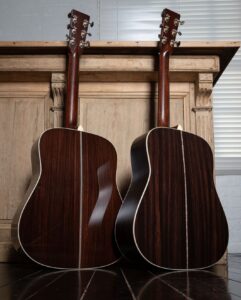Learning and using the right tips and techniques for restoring vintage guitars is essential to ensure your guitar stays in beautiful condition and ages gracefully.
 Do you have a passion for vintage guitars and want to preserve them for years to come? Or maybe you’ve already started exploring the world of antique guitars but don’t quite know where to start when it comes to restoration. Whatever your level of experience, restoring vintage instruments can be an advantageous process, both in terms of preservation and personal satisfaction. In this article, we will discuss some simple tips and techniques that will help you easily restore your beloved vintage guitars. From understanding the basics tools necessary, creating a plan of action and selecting materials wisely, we’ll cover everything you need to know about getting started on the road to successful guitar restoration!
Do you have a passion for vintage guitars and want to preserve them for years to come? Or maybe you’ve already started exploring the world of antique guitars but don’t quite know where to start when it comes to restoration. Whatever your level of experience, restoring vintage instruments can be an advantageous process, both in terms of preservation and personal satisfaction. In this article, we will discuss some simple tips and techniques that will help you easily restore your beloved vintage guitars. From understanding the basics tools necessary, creating a plan of action and selecting materials wisely, we’ll cover everything you need to know about getting started on the road to successful guitar restoration!
Vintage guitars have a rich history that continues to captivate musicians and collectors alike. Every guitar has unique qualities that contribute to its sound and feel, but vintage guitars stand out for their exceptional craftsmanship and quality. Whether it’s the silky smooth action of a 1950s Fender Stratocaster or the rich, resonant tone of a 1960s Gibson Les Paul, these instruments are cherished for their unparalleled sound and playability. The history of vintage guitars is a fascinating journey through the evolution of music and technology, and it’s a story that continues to be written with every new generation of players who discover the magic of these timeless instruments.
The vintage guitar quality is an essential factor to consider when purchasing a new instrument. Before committing to a guitar, it is crucial to identify and assess the condition of the instrument. Issues such as cracks, warping, or loose parts can greatly affect the playability and sound of the guitar. To properly assess a guitar’s condition, it is recommended to inspect the body, neck, and hardware. Additionally, playing the guitar will help identify any issues with sound and playability. By assessing a guitar’s condition properly, you will ensure that you are investing in a high-quality instrument that will last for years to come.
When it comes to vintage guitar quality, cleaning and inspecting for damage, cracks, and needed repairs is absolutely essential. Whether you’re a professional musician or just starting, taking care of your instrument is of utmost importance. Not only does regular maintenance ensure that your guitar stays in good working order, but it can also improve its overall sound and playability. By taking the time to clean and inspect your guitar, you’ll be able to identify any potential issues before they become bigger problems. From there, you can make the necessary repairs or adjustments to get your guitar back to tip-top shape. So if you want to maintain your guitar’s quality and get the most out of your playing experience, don’t skip out on the cleaning and inspection process!
By learning and employing the tips and techniques for restoring vintage guitars, you can keep your guitar playing beautifully and age gracefully. Taking the time to repair these beautiful instruments will invest in their future as much as their past. With a little bit of elbow grease, knowledge, and dedication, you’ll have priceless quality instruments that sound even better than when they were first made. Restoring vintage guitars not only takes artistic vision and patience but also respect for the musical history that has been passed down through generations. Cultivate an appreciation for vintage instruments by restoring them with precision and care; it’s a skill that is sure to add growth and enrichment to your journey as a musician!